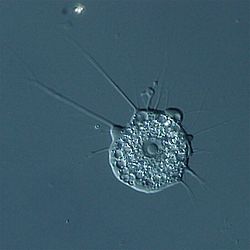| ホロマイコータ
|
|
|
 Nuclearia
|
| 分類
|
|
|
| 学名
|
Holomycota
Liu et al., 2009[1]
|
| シノニム
|
|
|
| 下位分類群
|
|
(本文参照)
|
ホロマイコータ(Holomycota)またはNucletmycea[注釈 1]は、真菌とそれに近縁な原生生物を含むクレードである。オピストコンタに属し、後生動物とそれに近縁な原生生物を含むホロゾアとは対をなす。
系統
おおよそ以下のような系統関係が示されている[4][5][6]。
注釈
- ^ HolomycotaとNucletmyceaは同時期に提唱されておりシノニムの関係にある。Nucletmyceaが先に出版されているが、Holozoaとの対称性からHolomycotaの方が好んで使われている[3]。生物命名法の一般論として先取権は尊重されるべきであるが、この2つの名称について先取権の適用を強制する規約は存在しない。
- ^ 当初Opisthosporidiaに含まれると考えられていたが、よりツボカビ門に近い派生的な位置から分岐する傾向が認められている[4]
- ^ Fungiの範囲は自明ではないが、ここでは系統学的な定義[7]に依った。
参考文献
- ^ Liu et al. (2009). “Phylogenomic analyses predict sistergroup relationship of nucleariids and Fungi and paraphyly of zygomycetes with significant support”. BMC Evol. Biol. 9 (1): 272. doi:10.1186/1471-2148-9-272.
- ^ Brown et al. (2009). “Phylogeny of the "forgotten" cellular slime mold, Fonticula alba, reveals a key evolutionary branch within Opisthokonta”. Mol. Biol. Evol. 26 (12): 2699–2709. doi:10.1093/molbev/msp185.
- ^ Adl et al. (2019). “Revisions to the Classification, Nomenclature, and Diversity of Eukaryotes”. J. Eukaryot. Microbiol. 66: 4-119. doi:10.1111/jeu.12691.
- ^ a b Torruella et al. (2018). “Global transcriptome analysis of the aphelid Paraphelidium tribonemae supports the phagotrophic origin of fungi”. Comm. Biol. 1 (1): 231. doi:10.1038/s42003-018-0235-z.
- ^ Hibbett et al. (2018). “Phylogenetic taxon definitions for Fungi, Dikarya, Ascomycota and Basidiomycota”. IMA Fungus 9 (2): 291-298. doi:10.5598/imafungus.2018.09.02.05.
- ^ Tedersoo et al. (2018). “High-level classification of the Fungi and a tool for evolutionary ecological analyses”. Fungal Diversity 90 (1): 135-159. doi:10.1007/s13225-018-0401-0.
- ^ Hibbett et al. (2018). “Phylogenetic taxon definitions for Fungi, Dikarya, Ascomycota and Basidiomycota”. IMA Fungus 9: 291-298. doi:10.5598/imafungus.2018.09.02.05.
関連項目